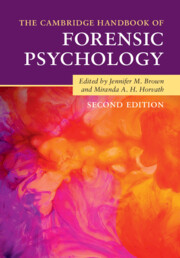Book contents
- The Cambridge Handbook of Forensic Psychology
- The Cambridge Handbook of Forensic Psychology
- Copyright page
- Dedication
- Contents
- Figures
- Tables
- Contributors
- Preface
- Forensic Psychology
- Part I Psychological Underpinnings
- Part II Psychology and Criminal Behaviour
- 2.1 Current Understandings of Sex-Based Harassment and Stalking Perpetration
- 2.2 The Behaviour of Sex Offenders
- 2.3 Intimate Partner Violence
- 2.4 Acquisitive Crime
- 2.5 Terrorism Research
- 2.6 Online Child Sexual Exploitation and Abuse
- 2.7 Arson
- 2.8 Serial Killings and Mass Murder
- Part III Assessment
- Part IV Interventions
- Part V Civil Proceedings
- Part VI Professional Practices
- Index
- References
2.8 - Serial Killings and Mass Murder
from Part II - Psychology and Criminal Behaviour
Published online by Cambridge University Press: 02 December 2021
- The Cambridge Handbook of Forensic Psychology
- The Cambridge Handbook of Forensic Psychology
- Copyright page
- Dedication
- Contents
- Figures
- Tables
- Contributors
- Preface
- Forensic Psychology
- Part I Psychological Underpinnings
- Part II Psychology and Criminal Behaviour
- 2.1 Current Understandings of Sex-Based Harassment and Stalking Perpetration
- 2.2 The Behaviour of Sex Offenders
- 2.3 Intimate Partner Violence
- 2.4 Acquisitive Crime
- 2.5 Terrorism Research
- 2.6 Online Child Sexual Exploitation and Abuse
- 2.7 Arson
- 2.8 Serial Killings and Mass Murder
- Part III Assessment
- Part IV Interventions
- Part V Civil Proceedings
- Part VI Professional Practices
- Index
- References
Summary
Homicide is as old as human existence and, likewise, mass murder and serial killings are not recent phenomena. Having adopted formal definitions in the 1980s’s both mass murder and serial homicide are often mistakenly equated; however, the two phenomena are distinct as evidenced by wider patterns of violence, victimization, and psychopathology. This chapter provides an overview of mass murder and serial homicide including definitions and selected case studies. Seeking to clarify the distinctions between perpetrators of mass murder and serial homicide, this chapter also provides information on the psychopathology of each type of offender and provides a brief examination of the developmental experiences and victim choice of the perpetrators.
- Type
- Chapter
- Information
- The Cambridge Handbook of Forensic Psychology , pp. 317 - 336Publisher: Cambridge University PressPrint publication year: 2021

